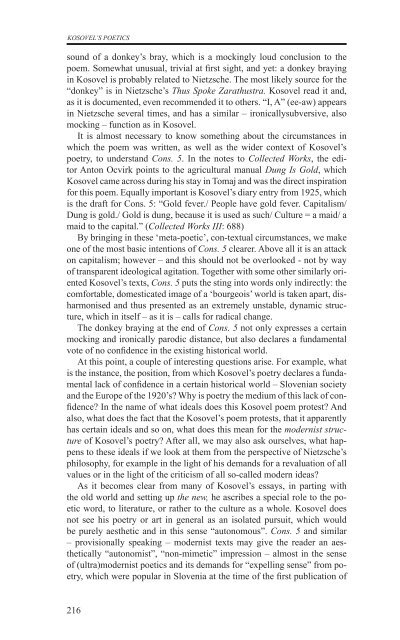razprave (pdf) - Društvo za primerjalno književnost - ZRC SAZU
razprave (pdf) - Društvo za primerjalno književnost - ZRC SAZU
razprave (pdf) - Društvo za primerjalno književnost - ZRC SAZU
- No tags were found...
Create successful ePaper yourself
Turn your PDF publications into a flip-book with our unique Google optimized e-Paper software.
KOSOVEL’s poeticssound of a donkey’s bray, which is a mockingly loud conclusion to thepoem. Somewhat unusual, trivial at first sight, and yet: a donkey brayingin Kosovel is probably related to Nietzsche. The most likely source for the“donkey” is in Nietzsche’s Thus Spoke Zarathustra. Kosovel read it and,as it is documented, even recommended it to others. “I, A” (ee-aw) appearsin Nietzsche several times, and has a similar – ironicallysubversive, alsomocking – function as in Kosovel.It is almost necessary to know something about the circumstances inwhich the poem was written, as well as the wider context of Kosovel’spoetry, to understand Cons. 5. In the notes to Collected Works, the editorAnton Ocvirk points to the agricultural manual Dung Is Gold, whichKosovel came across during his stay in Tomaj and was the direct inspirationfor this poem. Equally important is Kosovel’s diary entry from 1925, whichis the draft for Cons. 5: “Gold fever./ People have gold fever. Capitalism/Dung is gold./ Gold is dung, because it is used as such/ Culture = a maid/ amaid to the capital.” (Collected Works III: 688)By bringing in these ‘meta-poetic’, con-textual circumstances, we makeone of the most basic intentions of Cons. 5 clearer. Above all it is an attackon capitalism; however – and this should not be overlooked - not by wayof transparent ideological agitation. Together with some other similarly orientedKosovel’s texts, Cons. 5 puts the sting into words only indirectly: thecomfortable, domesticated image of a ‘bourgeois’ world is taken apart, disharmonisedand thus presented as an extremely unstable, dynamic structure,which in itself – as it is – calls for radical change.The donkey braying at the end of Cons. 5 not only expresses a certainmocking and ironically parodic distance, but also declares a fundamentalvote of no confidence in the existing historical world.At this point, a couple of interesting questions arise. For example, whatis the instance, the position, from which Kosovel’s poetry declares a fundamentallack of confidence in a certain historical world – Slovenian societyand the Europe of the 1920’s? Why is poetry the medium of this lack of confidence?In the name of what ideals does this Kosovel poem protest? Andalso, what does the fact that the Kosovel’s poem protests, that it apparentlyhas certain ideals and so on, what does this mean for the modernist structureof Kosovel’s poetry? After all, we may also ask ourselves, what happensto these ideals if we look at them from the perspective of Nietzsche’sphilosophy, for example in the light of his demands for a revaluation of allvalues or in the light of the criticism of all so-called modern ideas?As it becomes clear from many of Kosovel’s essays, in parting withthe old world and setting up the new, he ascribes a special role to the poeticword, to literature, or rather to the culture as a whole. Kosovel doesnot see his poetry or art in general as an isolated pursuit, which wouldbe purely aesthetic and in this sense “autonomous”. Cons. 5 and similar– provisionally speaking – modernist texts may give the reader an aesthetically“autonomist”, “non-mimetic” impression – almost in the senseof (ultra)modernist poetics and its demands for “expelling sense” from poetry,which were popular in Slovenia at the time of the first publication of216
















